Abstract
Embryo cryopreservation does not induce clear-cut anomalies at detectable rates, but several mechanisms exist for nonlethal damage during the freeze-thaw process, and the risk of moderate or delayed consequences has not been extensively investigated. In a long-term study including senescence, we compared cryopreserved and control mice for several quantitative traits. Significant differences were seen in morphophysiological and behavioral features, some of them appearing in elderly subjects. Thus, apart from its immediate toxicity, embryo cryopreservation, without being severely detrimental, may have delayed effects. These results, consistent with other findings, question the neutrality of artificial reproductive technologies and draw attention to the preimplantation stages in developmental toxicology.
Full text
PDF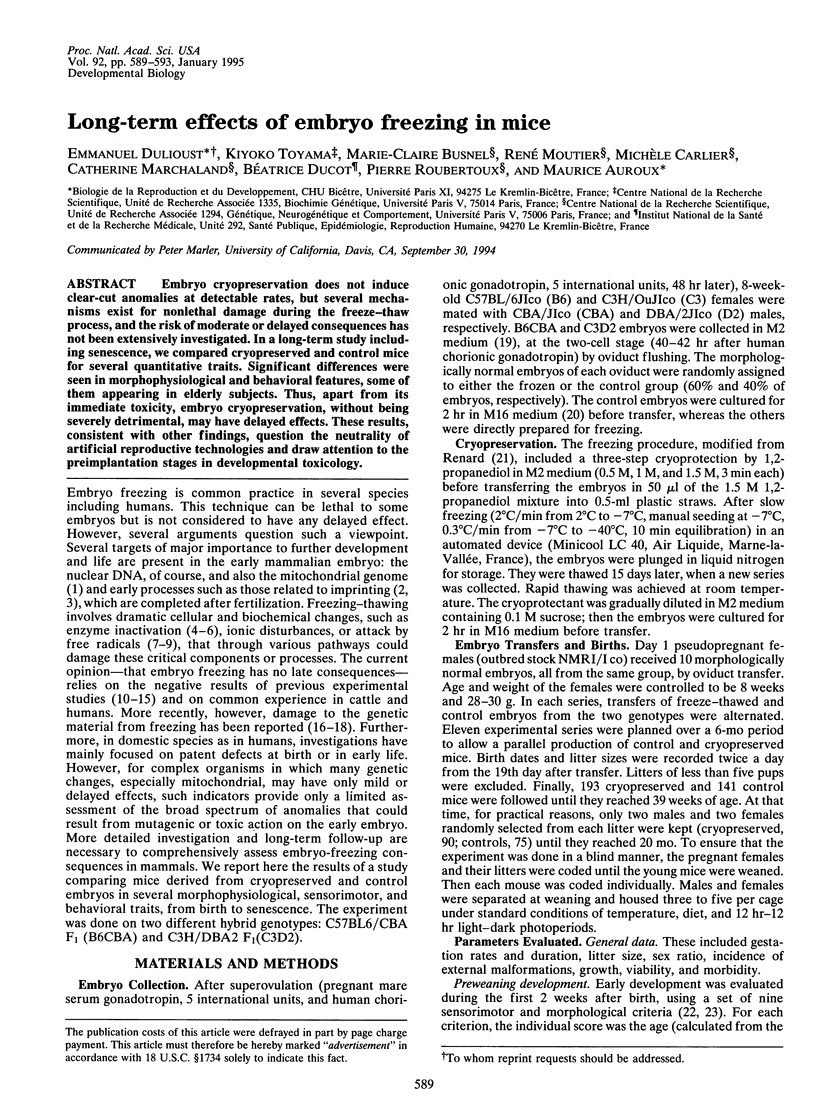
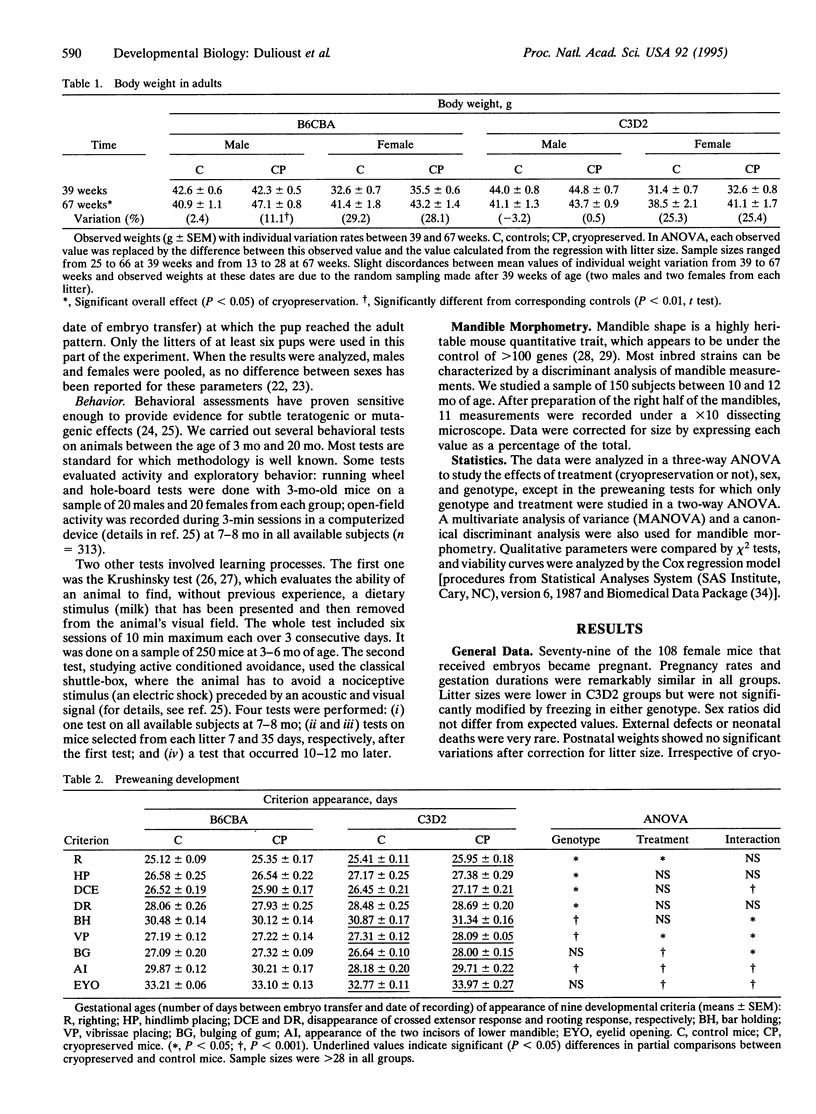
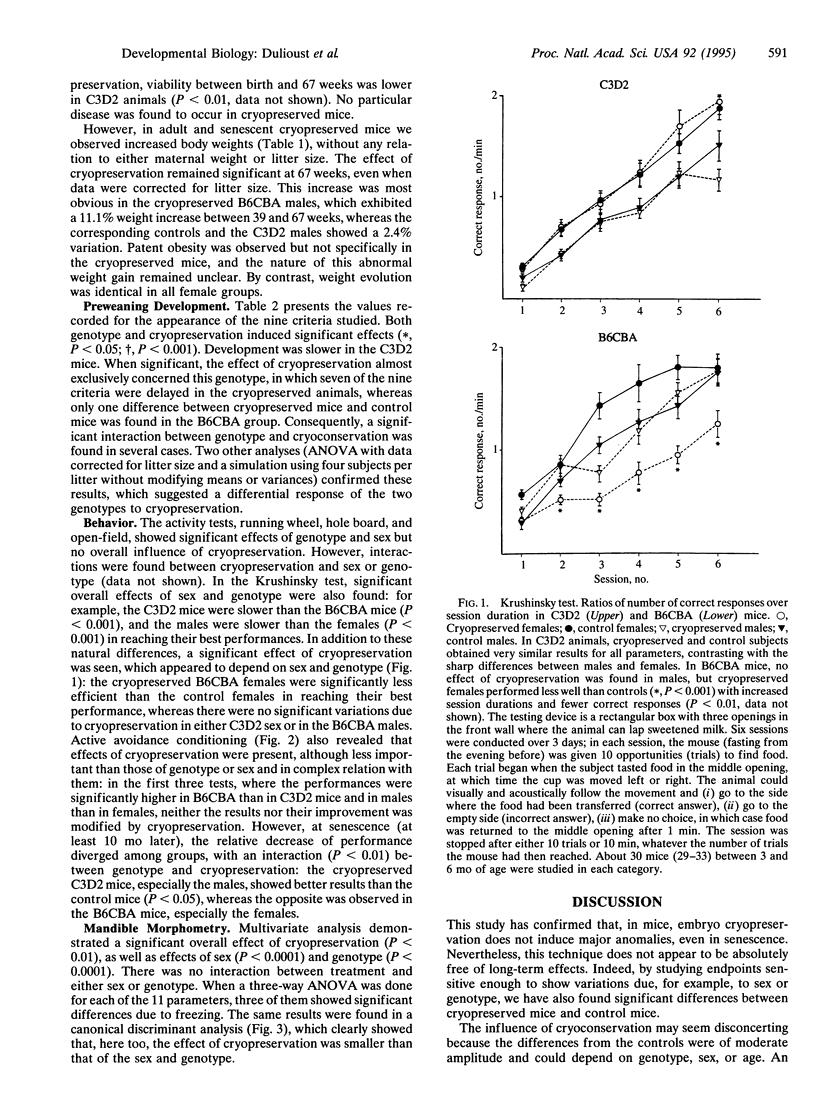
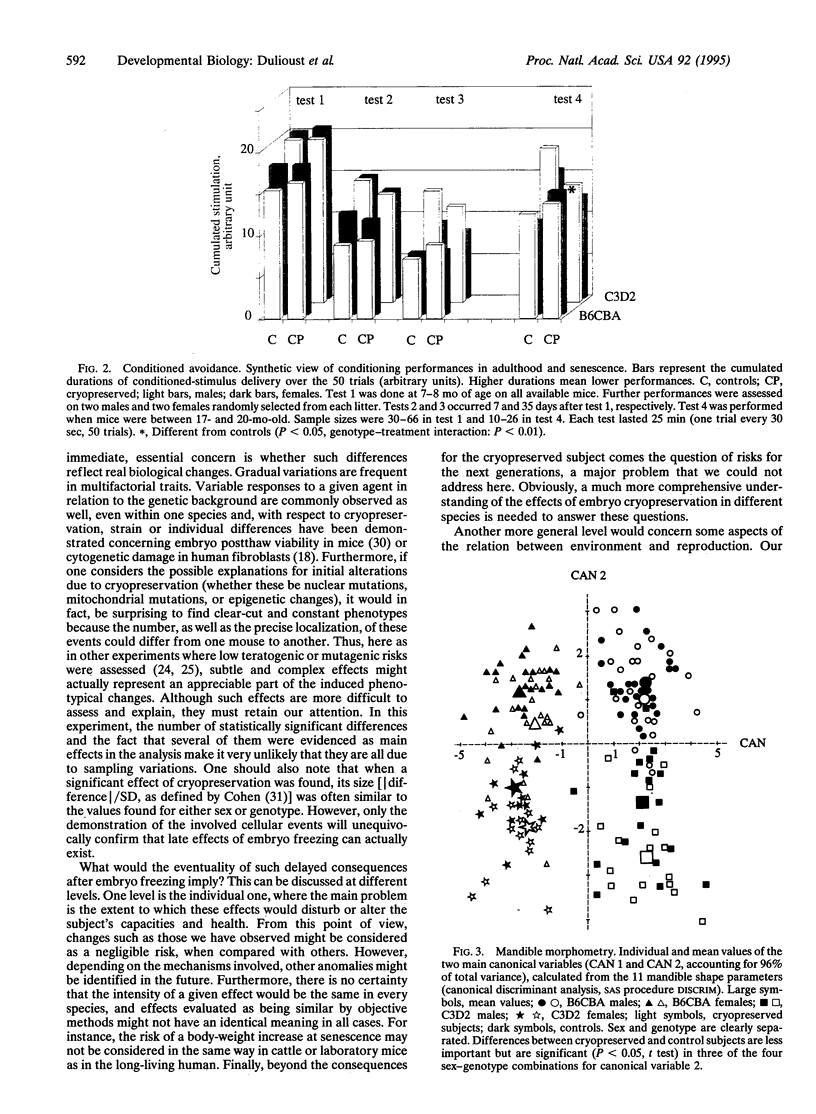
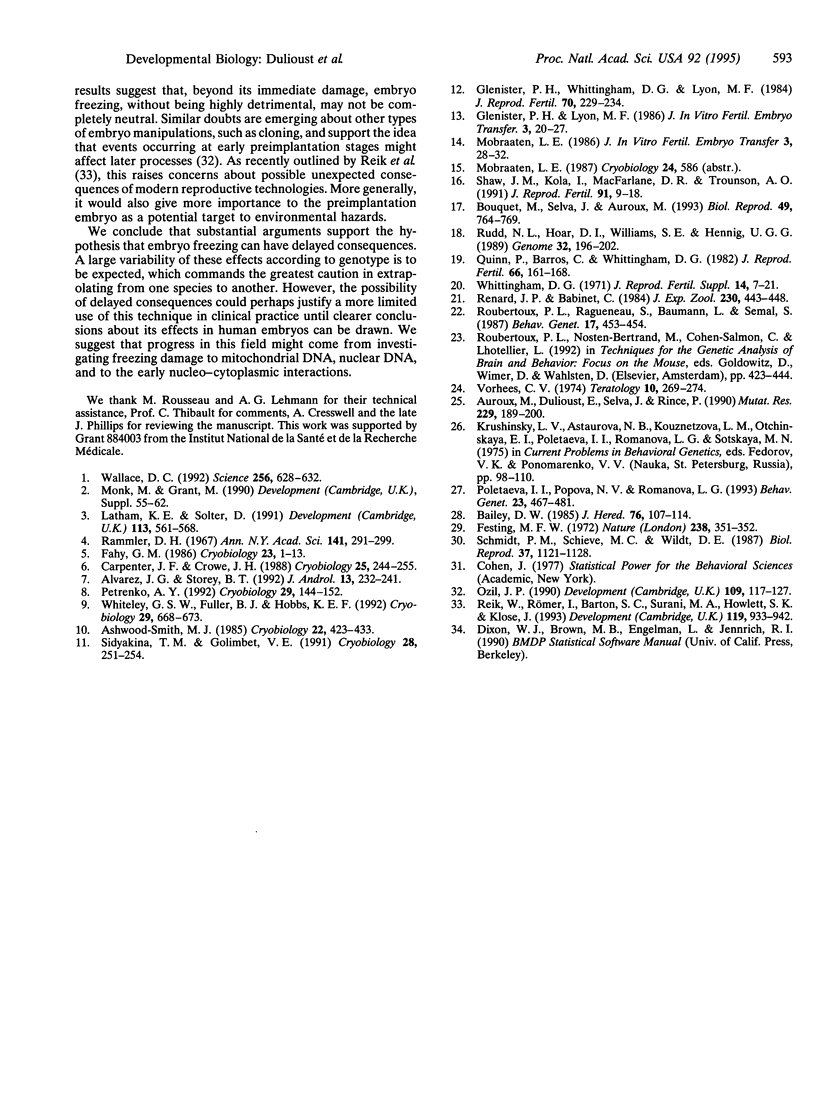
Images in this article
Selected References
These references are in PubMed. This may not be the complete list of references from this article.
- Alvarez J. G., Storey B. T. Evidence for increased lipid peroxidative damage and loss of superoxide dismutase activity as a mode of sublethal cryodamage to human sperm during cryopreservation. J Androl. 1992 May-Jun;13(3):232–241. [PubMed] [Google Scholar]
- Ashwood-Smith M. J. Genetic damage is not produced by normal cryopreservation procedures involving either glycerol or dimethyl sulfoxide: a cautionary note, however, on possible effects of dimethyl sulfoxide. Cryobiology. 1985 Oct;22(5):427–433. doi: 10.1016/0011-2240(85)90153-1. [DOI] [PubMed] [Google Scholar]
- Auroux M., Dulioust E., Selva J., Rince P. Cyclophosphamide in the F0 male rat: physical and behavioral changes in three successive adult generations. Mutat Res. 1990 Apr;229(2):189–200. doi: 10.1016/0027-5107(90)90093-j. [DOI] [PubMed] [Google Scholar]
- Bailey D. W. Genes that affect the shape of the murine mandible. Congenic strain analysis. J Hered. 1985 Mar-Apr;76(2):107–114. doi: 10.1093/oxfordjournals.jhered.a110033. [DOI] [PubMed] [Google Scholar]
- Bouquet M., Selva J., Auroux M. Cryopreservation of mouse oocytes: mutagenic effects in the embryo? Biol Reprod. 1993 Oct;49(4):764–769. doi: 10.1095/biolreprod49.4.764. [DOI] [PubMed] [Google Scholar]
- Carpenter J. F., Crowe J. H. The mechanism of cryoprotection of proteins by solutes. Cryobiology. 1988 Jun;25(3):244–255. doi: 10.1016/0011-2240(88)90032-6. [DOI] [PubMed] [Google Scholar]
- Fahy G. M. The relevance of cryoprotectant "toxicity" to cryobiology. Cryobiology. 1986 Feb;23(1):1–13. doi: 10.1016/0011-2240(86)90013-1. [DOI] [PubMed] [Google Scholar]
- Festing M. Mouse strain identification. Nature. 1972 Aug 11;238(5363):351–352. doi: 10.1038/238351a0. [DOI] [PubMed] [Google Scholar]
- Glenister P. H., Lyon M. F. Long-term storage of eight-cell mouse embryos at - 196 degrees C. J In Vitro Fert Embryo Transf. 1986 Feb;3(1):20–27. doi: 10.1007/BF01131376. [DOI] [PubMed] [Google Scholar]
- Glenister P. H., Whittingham D. G., Lyon M. F. Further studies on the effect of radiation during the storage of frozen 8-cell mouse embryos at -196 degrees C. J Reprod Fertil. 1984 Jan;70(1):229–234. doi: 10.1530/jrf.0.0700229. [DOI] [PubMed] [Google Scholar]
- Latham K. E., Solter D. Effect of egg composition on the developmental capacity of androgenetic mouse embryos. Development. 1991 Oct;113(2):561–568. doi: 10.1242/dev.113.2.561. [DOI] [PubMed] [Google Scholar]
- Mobraaten L. E. Mouse embryo cryobanking. J In Vitro Fert Embryo Transf. 1986 Feb;3(1):28–32. doi: 10.1007/BF01131377. [DOI] [PubMed] [Google Scholar]
- Monk M., Grant M. Preferential X-chromosome inactivation, DNA methylation and imprinting. Dev Suppl. 1990:55–62. [PubMed] [Google Scholar]
- Ozil J. P. The parthenogenetic development of rabbit oocytes after repetitive pulsatile electrical stimulation. Development. 1990 May;109(1):117–127. doi: 10.1242/dev.109.1.117. [DOI] [PubMed] [Google Scholar]
- Petrenko AYu A mechanism of latent cryoinjury and reparation of mitochondria. Cryobiology. 1992 Feb;29(1):144–152. doi: 10.1016/0011-2240(92)90015-t. [DOI] [PubMed] [Google Scholar]
- Poletaeva I. I., Popova N. V., Romanova L. G. Genetic aspects of animal reasoning. Behav Genet. 1993 Sep;23(5):467–475. doi: 10.1007/BF01067982. [DOI] [PubMed] [Google Scholar]
- Quinn P., Barros C., Whittingham D. G. Preservation of hamster oocytes to assay the fertilizing capacity of human spermatozoa. J Reprod Fertil. 1982 Sep;66(1):161–168. doi: 10.1530/jrf.0.0660161. [DOI] [PubMed] [Google Scholar]
- Rammler D. H. The effect of DMSO on several enzyme systems. Ann N Y Acad Sci. 1967 Mar 15;141(1):291–299. doi: 10.1111/j.1749-6632.1967.tb34893.x. [DOI] [PubMed] [Google Scholar]
- Reik W., Römer I., Barton S. C., Surani M. A., Howlett S. K., Klose J. Adult phenotype in the mouse can be affected by epigenetic events in the early embryo. Development. 1993 Nov;119(3):933–942. doi: 10.1242/dev.119.3.933. [DOI] [PubMed] [Google Scholar]
- Renard J. P., Babinet C. High survival of mouse embryos after rapid freezing and thawing inside plastic straws with 1-2 propanediol as cryoprotectant. J Exp Zool. 1984 Jun;230(3):443–448. doi: 10.1002/jez.1402300313. [DOI] [PubMed] [Google Scholar]
- Roubertoux P. L., Baumann L., Ragueneau S., Semal C. Early development in mice. IV. Age at disappearance of the rooting response: genetic analysis in newborn mice. Behav Genet. 1987 Sep;17(5):453–464. doi: 10.1007/BF01073112. [DOI] [PubMed] [Google Scholar]
- Rudd N. L., Hoar D. I., Williams S. E., Hennig U. G. Genotype and the cryopreservation process affect the levels of aneuploidy and chromosome breakage in cultured human fibroblasts. Genome. 1989 Apr;32(2):196–202. doi: 10.1139/g89-429. [DOI] [PubMed] [Google Scholar]
- Schmidt P. M., Schiewe M. C., Wildt D. E. The genotypic response of mouse embryos to multiple freezing variables. Biol Reprod. 1987 Dec;37(5):1121–1128. doi: 10.1095/biolreprod37.5.1121. [DOI] [PubMed] [Google Scholar]
- Shaw J. M., Kola I., MacFarlane D. R., Trounson A. O. An association between chromosomal abnormalities in rapidly frozen 2-cell mouse embryos and the ice-forming properties of the cryoprotective solution. J Reprod Fertil. 1991 Jan;91(1):9–18. doi: 10.1530/jrf.0.0910009. [DOI] [PubMed] [Google Scholar]
- Sidyakina T. M., Golimbet V. E. Viability and genetic stability of the bacterium Escherichia coli HB101 with the recombinant plasmid during preservation by various methods. Cryobiology. 1991 Jun;28(3):251–254. doi: 10.1016/0011-2240(91)90030-r. [DOI] [PubMed] [Google Scholar]
- Vorhees C. V. Some behavioral effects of maternal hypervitaminosis A in rats. Teratology. 1974 Dec;10(3):269–273. doi: 10.1002/tera.1420100309. [DOI] [PubMed] [Google Scholar]
- Wallace D. C. Mitochondrial genetics: a paradigm for aging and degenerative diseases? Science. 1992 May 1;256(5057):628–632. doi: 10.1126/science.1533953. [DOI] [PubMed] [Google Scholar]
- Whiteley G. S., Fuller B. J., Hobbs K. E. Deterioration of cold-stored tissue specimens due to lipid peroxidation: modulation by antioxidants at high subzero temperatures. Cryobiology. 1992 Dec;29(6):668–673. doi: 10.1016/0011-2240(92)90069-e. [DOI] [PubMed] [Google Scholar]
- Whittingham D. G. Culture of mouse ova. J Reprod Fertil Suppl. 1971 Jun;14:7–21. [PubMed] [Google Scholar]



